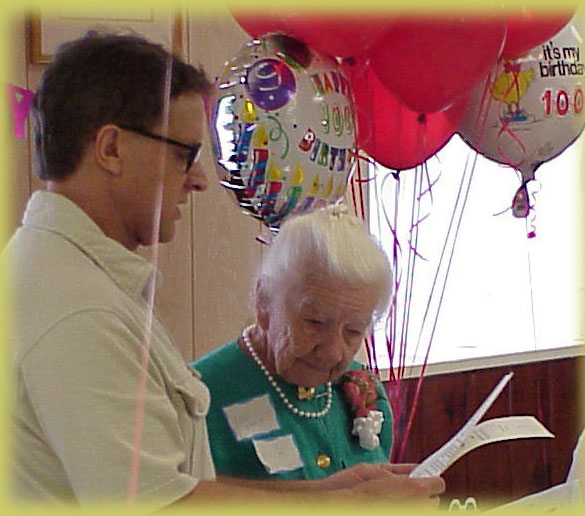

neighborhood association
Austin, Texas
It's not every day! Mrs. Eula Matthews recently embarked upon her second century. Gathering June 24 in celebration of her one-hundredth birthday at Grace Methodist Church were many friends and neighbors. Also marking this milestone were proclamations in her honor issued by Governor Rick Perry and by Austin Mayor Kirk Watson.

This photo and others are courtesy of and available from René Barrera.
Business
group says city rules hinder growth
By Peggy Vlerebome
Austin American-Statesman
Too much government stands in the way of downtown
redevelopment and expansion, says a downtown business
group that envisions a business district extending south
to Oltorf Street where older residential neighborhoods
now are.
Downtown Austin Unlimited, a 22-year-old organization,
says that Austinites have to accept that downtown is
going to grow in size, height and density, and plan for
it now.
Redevelopment suffers from city rules that protect older,
single-family neighborhoods, restrict building heights
and discourage high density housing, the group says in a
position paper.
In addition to removing the restrictions, Downtown Austin
Unlimited wants central business district boundaries to
be redefined now and reviewed every two years.
"We're not suggesting that anyone's home be taken
from them or their zoning be changed," Warran
Beaman, executive director of Downtown Austin Unlimited,
said Wednesday, "but downtown has got to expand
somewhere."
Beaman said he has lost three homes to growth-one
displaced by the interstate, another by the airport and
another by the LBJ Library-but has no ill-feeling because
"those are things that are going to happen."
By the turn of the century, the group predicts, the
central business district will go south to Oltorf Street
and in some places, east to Interstate 35 and west to
Lamar Boulevard.
The central business district includes land south of the
Capitol, east of Lamar and west of Interstate 35. The
southern boundary crosses Town Lake and is jagged. Beaman
says the land has been "gerrymanded" [sic] as
land is developed instead of being set ahead of
development.
Downtown Austin Unlimited wants the southern limit to be
set at Riverside Drive and Barton Springs Road between I-35
and Lamar. The suggested review would allow the Planning
Commission to extend the boundary up to 1,000 feet every
two years.
There are only two directions that downtown can grow, and
only one of them is suitable, the group says. The city
can't grow north or east because the land is owned by the
state, the University of Texas or by the city for urban
renewal.
"From the west, we're fairly well locked in because
no one in his right mind would want to change the use on
West Avenue and all those beautiful houses," Beaman
said.
That leaves the south as the direction for growth. Travis
Heights and downtown neighborhoods along East and West
Bouldin creeks will be within the boundaries of what
Downtown Austin Unlimited expects to be the business
district by 2000.
Of Travis Heights, Beaman said, "It is only a matter
of time before a number of blocks in that area become CBD
(central business district); there's just no other place
for downtown to go."
The central business district must be allowed to expand
upward, Beaman said. High-rise housing with more density
would save gasoline and be a healthy addition to the
city's property tax base, the group says.
The group's directors include bankers, developers,
business owners, a realtor, a downtown resident and
American Statesman business manager Harold Cline.
Dorothy Rowland, vice president of Texas Commerce Bank,
is chairman of the board. J. Burton Casey, of Watson-Casey
Companies, is vice chairman. David Davenport, vice
president of Austin National Bank, is treasurer. Beaman,
the executive director, owns a public relations and
advertising agency.